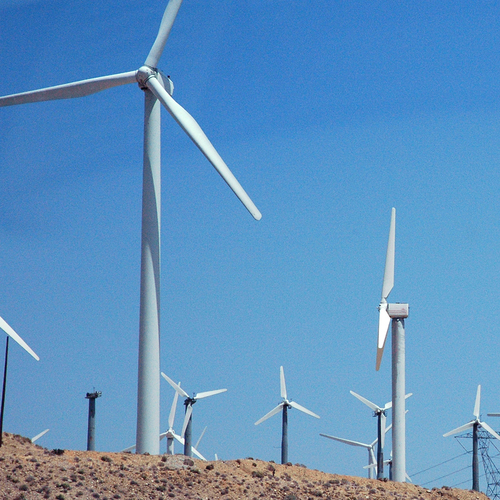
Image Credit: Michael Surran via Wikimedia Commons
A Texas-based renewable energy company is proposing what would be largest wind farm in New England, a 250-megawatt facility with as many as 125 turbines built in parts of five townships in Aroostook County.
EDP Renewables outlined its plans at a public meeting earlier this month, and is expected to file for permits with the state Department of Environmental Protection by the end of November, according an article in The Bangor Daily News.
The wind project would include either 125 two-megawatt turbines or 83 three-megawatt turbines — which option wasn’t immediately clear — and produce enough electricity for more than 51,000 homes. The $1 billion project, financed through power purchase agreements with Connecticut utilities, would involve lease and easement agreements for 58,000 acres of land in five townships in Maine’s unorganized territory.
The area is west of Route 1 near Bridgewater, just southwest of an existing 28-turbine wind facility in Mars Hill. EDP’s project manager calls the region the “Holy Grail” for commercial wind development, according to the newspaper. Number Nine Farm, named for the mountain on which it would be located, would dwarf the largest wind farm approved to date in Maine, a 62-turbine First Wind project approved by the state in September.
Officials at EDP Renewables could not be reached.
The mothballed project is revived
The project was first proposed in 2007, The BDN said, but was shelved because of concerns over transmitting the power efficiently to the New England grid, and the availability of long-term contracts for the power. Those issues have apparently have been resolved.
In an earlier article, the newspaper explained the interest in developing Maine’s ample wind resources is being driven by requirements in Connecticut and Massachusetts that a certain amount of electricity be generated by renewable sources.
Wind farms aren’t as easily located in those states, but Maine’s “more permissive siting culture” makes it attractive for companies like EDP, the newspaper reported.
EDP is a multinational corporation. Its North American offices are located in Houston, overseeing wind farms in 11 states with a total rated capacity of 3,476 MW. Its European operations are managed from Madrid. The company’s website says EDP’s major shareholder is Energias de Portugal, S.A., a vertically integrated utility company headquartered in Lisbon, Portugal.
Environmental advocates object
Opposition to the new project in Maine will come from a group called Friends of Maine’s Mountains, which objects to wind development for a number of reasons, including its negative impact on tourism, a major state industry, and its impact on power prices.
“In Maine, turbines do nothing to get us off oil,” the group’s website says. “Our electricity already comes from overwhelmingly clean sources.
“You thought wind was going to REDUCE your energy bill? Oh dear. We’ll try to let you down gently,” the website says. “You know the transmission lines Maine lawmakers are requiring you to buy, so that Massachusetts and Connecticut can get their ‘clean’ energy and feel good about themselves? Each time you elect these lawmakers, you’re begging them to raise your electric bill.”
The group worries the new wind facility will affect views from Baxter State Park to the south — Baxter State Park is a major draw for hikers and outdoor enthusiasts — and that a new transmission line built for the project would encourage even more wind development, degrading land values in the area, The Bangor Daily New said.
According to ISO-New England, which manages almost all of New England’s grid, wind turbines generated about 1.6 percent of the region’s total in 2013, more than 1,700 gigawatt hours of electricity. In Maine, wind capacity totals 432 MW, 390 on the ISO-New England grid, and another 42 MW in a separate grid in the northern part of the state called the Northern Maine Independent System Administrator.
At 250 MW, the new wind farm would boost the state’s total wind capacity by more than 50 percent.
Weekly Newsletter
Get building science and energy efficiency advice, plus special offers, in your inbox.















4 Comments
Wind Farm
Wrong name. It's a subsidy farm.
Tony.
Reply to Tony
The federal Production Tax Credit for wind power expired at the end of 2013. What subsidy are you talking about?
Viability of wind turbines
Perhaps this will provide some credibility "I will do anything that is basically covered by the law to reduce Berkshire's tax rate," Buffet told an audience in Omaha, Nebraska recently. "For example, on wind energy, we get a tax credit if we build a lot of wind farms. That's the only reason to build them. They don't make sense without the tax credit."
My understanding is that Congress is still considering a continuation of the (expired) act.
My analysis tells me that without a generous subsidy of some sort (open or concealed), no new wind farm is going to be viable. That subsidy includes not having to pay for 100% dispatchable backup.
About the Maine venture, I guess we shall have to wait and see.
Respectfully, Tony.
reply to Tony
Tony- there was an interesting article in the New York Times, Nov 23, by Diane Cardwell, discussing several wind projects that have negotiated long term power agreements with utilities at prices lower than coal or gas, even without subsidies. In some cases, these contracts were in states like OK, which don't have a renewable power requirement for utilities.
While Congress may retroactively extend the wind power subsidy, which I think is 2.5 cents per kwh, the annual discussion about renewal is not conducive to long-term planning.
Most of us would prefer a level playing field for power generation, but it can be hard to quantify covert subsidies. A nuclear power plant can only be built with federal insurance guarantees. Certainly that represents a subsidy.
Log in or create an account to post a comment.
Sign up Log in